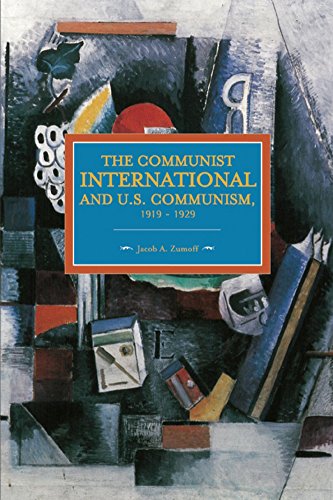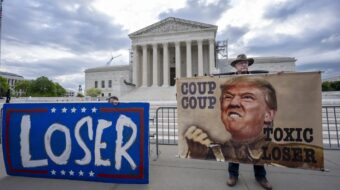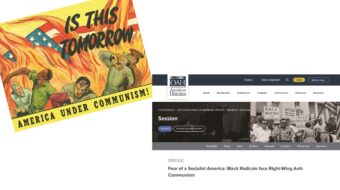
The history of U.S. communism and the Communist Party, USA isn’t an easy subject to write about. In fact, the Communist Party’s contributions to American democracy, workers’ rights, African American equality, peace, and a host of other issues, is still hotly contested.
Add into the mix the impact the Moscow-based Communist International (CI) had on U.S. communists and the subject becomes even more contested. Jacob A. Zumoff’s “The Communist International and US Communism, 1919-1929” is a welcomed addition to this complex, nuanced and contested history.
Zumoff offers a wealth of documentation to support the often positive, though sometimes negative, impact the CI had on U.S. communism.
He starts his analysis with a brief overview of the forces that coalesced around the Socialist Party, the IWW, and a number of other radical groups, to eventually found the Communist Party, USA and eventually seek support, guidance and legitimacy from the newly formed Soviet Union. An understanding of this uneasy partnership adds historical context to many of the inter-Party conflicts and divisions that would emerge over the ten-year period Zumoff writes about.
After dealing with the formation of the CPUSA, Zumoff switches gears and focuses on the Party’s “fight for legality” and the question of influence within mainstream workers’ organizations, primarily the conservative-led AFL trade unions.
While the CI based its tactics on “a systematic drive to win the majority of the working class, first and foremost within the old trade unions,” (italics in original) not all U.S. communists agreed. Additionally, while Lenin argued against “revolutionary impatience,” some communists – formerly of the IWW and/or other radical workers’ organizations which were born out of attempts to organize outside of the confines of a conservative, predominantly white AFL leadership structure – interpreted the ascending ‘Red Scare’ as evidence of the immediacy of revolution and the need to build so-called revolutionary unions, and an underground communist organization.
These questions, and others, helped to shape and mold communists’ perspective on legality. As Zumoff writes, “Trying to become a legal party became one of the first battlegrounds to ‘Americanize’ the Communist movement,” of which the CI played a decisive and positive role. In fact, CI leaders claimed “any delay in creating a legal party would be ‘a very great mistake,'” (italics in original) and that U.S. communists “should make use of every inch of the ground” and not “…lock ourselves in amongst ourselves.” It was added, that this was the “unquestionable instruction of the Comintern.”
Obviously, the newly-formed Communist Party and its leadership sincerely grappled with the right tactical and strategic approaches and actively sought the CI’s advice and guidance.
Zumoff is at his best when analyzing communists and the labor movement. While, “Most historians who study the influence of Communists in the trade-union movement usually begin in the 1930’s, skipping the party’s first decade to move on to the era of the CIO,” writes Zumoff, this ignores at least “two key aspects of Communist labour work in this period.”
“First…in the mid-1920’s, the vista for Communist work [in labor] appeared wide. Second, if Communist work in the labour movement did not pay immediate dividends, many of the cadres in the Communist movement in the 1920’s went on to play important roles in the 1930’s” with the emergence of the CIO. “Furthermore, the relationship between Communists and important labour leaders in the 1930’s – especially John L. Lewis – were conditioned by the party’s activities in the 1920’s.”
In short, the Party’s work within and outside of the conservative-led AFL, laid the ground work for the emerging CIO-led battles that would ultimately reshape the American labor movement in the years to come.
Party leader Max Bedacht argued that “[AFL president] Gompers, as well as the Industrial Workers of the World, wished and still wish one thing: that the revolutionary workers should leave the trade unions, i.e., they pursue the one and the same reactionary project.” However, his opinion was not shared by all communists at the time, and it was partly due to the CI’s prestige, influence and ideological insight that early U.S. communists shifted gears away from independent, radical – and isolating – unions and started the tedious, years-long effort of winning influence, trust and leadership among the masses of rank-and-file workers in conservative unions – an effort that would eventually payoff big-time, as the Communist Party would become the most influential radical, Marxist organization in the history of the American labor movement.
Zumoff also spends considerable time on the CI’s impact on the CP-affiliated foreign-language federations and their ultimate dismemberment, as well as on the internal power struggles within the Communist Party and the CI’s decisive influence on Party leadership at that time. The last four chapter deal with “The Negro Question” and the CI’s influence among black and white U.S. communists and the formation of the thesis on “Self-Determination.”
While I don’t agree with all of Zumoff’s arguments, The Communist International and US Communism, 1919-1929 is a detailed, nuanced book that analyses a very important period in U.S. communist history. It is a book worth reading. And reading again.
The Communist International and US Communism, 1919-1929
Jacob A. Zumoff
Brill, 2014, 443 pages












Comments